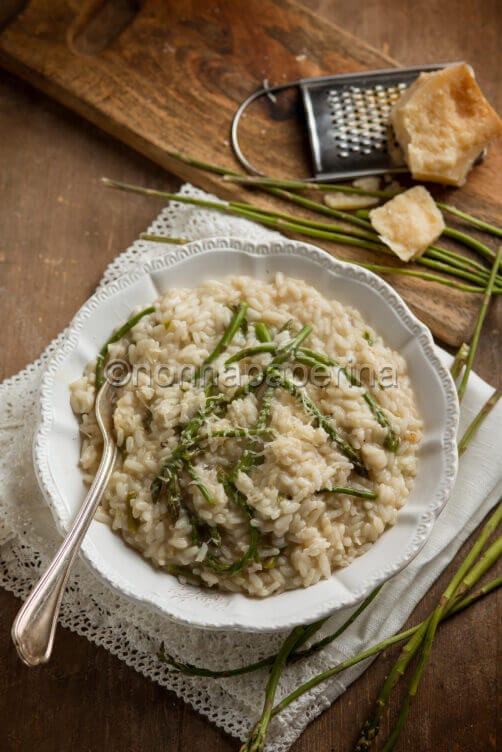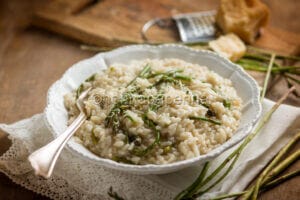
Asparagus fern risotto, a delicate and aromatic first course

Asparagus fern risotto, a classic and innovative dish
Although it still provides some novelties, the asparagus fern risotto is a part of the Italian risotto tradition. First of all, the ingredient list is a little unexpected. The herb being referred to is the asparagus fern, which is not a part of our tradition but is excellent from an organoleptic and nutritional standpoint. To make it even more delicious and flavourful, the asparagus fern risotto is cooked in hot water rather than broth. Finally, this risotto uses a special shallot-flavoured oil. This makes it possible to achieve lightness by excluding the sautéing process. The type of rice is constant though; you must always use the Carnaroli rice.
Carnaroli is the perfect rice variety for this type of preparation because it does not overcook and sucks liquids and flavours while releasing a considerable amount of starch at the same time. It’s precisely because of this that risottos cooked with Carnaroli are quite creamy and delicious. The texture is also influenced by the final creaming. The final creaming also affects the texture. Let’s go back to Carnaroli rice for a moment. It is relatively new, even though it is one of the mainstays of Italian cooking. It was in fact discovered during the post-war period by the agronomist Ettore de Vecchi, starting with the Vialone Nero and Lavarone rice. Because of its qualities, it became the preferred rice for risottos right away.
Recipe Asparagus fern risotto
Preparation Asparagus fern risotto
- To prepare the asparagus fern risotto, wash, clean, and cut the asparagus fern into pieces, setting aside the tips.
- Brown the asparagus fern with a little shallot oil, then cover it and continue cooking for about 10 minutes, but not before seasoning with salt and pepper.
- In a separate pan, toast the rice with a little hot shallot oil.
- After that, add the white wine and lower the heat.
- Now add the asparagus fern tips (save some for the following steps) and the hot water slowly.
- Cook the rice according to the instructions on the package. If necessary, add a little salt.
- In the meantime, blend the asparagus fern stalks with the blender until they become a cream.
- Add the cream to the rice, turn off the heat, and stir in the butter and grated Grana Padano cheese.
- Cover it and wait a couple of minutes.
- Finally, garnish with the tips you set aside. Serve and enjoy your meal.
Ingredients Asparagus fern risotto
- 400 grams asparagus fern
- shallot oil
- 360 gr. of Carnaroli rice
- half a glass of white wine
- 40 gr. of clarified butter
- 70 gr. of Grana Padano cheese
- a pinch of salt
- black pepper
A focus on asparagus fern
The protagonist of this delicate risotto is the asparagus fern, which, despite its similarity to asparagus, is very different from the latter. Of course, it looks very similar, but it belongs to a different family and is more closely related to garlic. The asparagus fern is originally from the Far East, but it can also grow in our area. It has richer and more fragrant overtones and a far more noticeable flavour than asparagus. The texture is only apparently leathery, so much so that cooking takes a few minutes. The asparagus fern also offers a lot on a nutritional level. It is rich in vitamin C (which is good for the immune system) and mineral salts, such as potassium, calcium, phosphorus, and magnesium.
As far as caloric intake is concerned, we are at low levels: 100 grams of asparagus fern provides only 35 kcal per 100 grams. For this recipe, the asparagus fern must be cleaned thoroughly and boiled. The tips must be added as they serve as a garnish both during the cooking stage and at the end. In contrast, the stems need to be blended before being introduced midway through the cooking process. Finally, the asparagus fern should not be confused with a substance (asparagine) of the same name present in asparagus, which is a beneficial amino acid with interesting properties.
A classic creaming for the asparagus fern risotto
The asparagus fern risotto follows some of the solutions of classic risottos. This is clear from the creaming, which is created with butter and shredded cheese. The butter must be clarified as it is free of casein, which allows it to better resist high temperatures without producing unpleasant burnt scents. Additionally, its flavour does not overpower the other ingredients because it is far more subtle than regular butter.

As for the grated cheese, you have several options available. Many prefer Parmigiano Reggiano cheese, but at least for this recipe I recommend using Grana Padano cheese. The Grana Padano cheese is characterized by a higher fat content, which is released during the stirring process, giving the risotto a creamier texture. From a nutritional perspective, the Parmigiano cheese has nothing over the Grana cheese; in fact, it is high in calcium, vitamin D, and proteins.
How is shallot oil made?
Among the strong points of the asparagus fern risotto is the absence of the sautéing process, replaced in a more than worthy manner by shallot oil. It is a flavoured oil, which is very effective both as a raw seasoning and as a supporting cooking oil (as it does here). How do you prepare shallot oil? It is very simple as long as you have a siphon. The correct quantities of extra virgin olive oil and shallot are 400 ml. and 200 grams, respectively.
The process consists of cutting the shallot into julienne strips and inserting it into the siphon. At this point, add the oil and load the gas. The shallot-flavoured oil is ready after two hours of absorption; just release the gas and filter the oil. This method eliminates the need for sautéing and saves a significant amount of time while producing an ideal outcome.
How to further enrich the asparagus fern risotto?
Although the asparagus fern risotto is delicious on its own, I think it could be enhanced and given a little more personality. Just add a few aromatic herbs just before cooking is done; I suggest parsley, sage, and thyme for this.
Thyme’s full-bodied, slightly citrus flavour complements asparagus fern wonderfully, bringing out the vegetable’s delicate qualities without overpowering it. Sage, with its intense and slightly peppery flavour, adds depth to the flavour of the asparagus fern, creating an interesting contrast between delicacy and intensity.
Lastly, the fresh and bitter accent of parsley adds personality to the risotto and highlights the delicate asparagus fern. Obviously, you have to use these aromatic herbs sparingly; in fact, they are very strong and therefore capable of overshadowing the other flavours.
A risotto for those with food intolerances
One of the advantages of this asparagus fern risotto is its total compatibility with coeliac disease and lactose intolerance. Coeliacs can sleep soundly thanks to the presence of rice, which is the gluten-free cereal par excellence.
Those who are lactose intolerant can do the same thanks to the fact that butter and Grana Padano cheese are essentially lactose-free. As I suggested a few paragraphs ago, the butter needs to be clarified, and the Grana Padano cheese needs to mature for at least 24 months. Long maturations, in fact, naturally degrade lactose.
What about people who are nickel-sensitive or allergic? The situation gets more complicated at this point. Nickel is not present in asparagus fern, but it is present in shallots, which are a key component in this dish, even though they are present in the form of oil. The shallots reduce some of their nickel concentration in this form, but there is still some risk. If the nickel intolerance is mild, you can prepare the recipe as I have presented it, but if the disorder is serious, it is better to give up this ingredient. Instead of shallot oil, you can use a regular extra virgin olive oil.
Asparagus Fern Risotto FAQs
Which rice should be used for the asparagus fern risotto?
Carnaroli rice is considered the best for risotto. This is due to its ability to remain compact while cooking and release starch, resulting in a creamy consistency. Other useful rice varieties are the Arborio, Vialone Nano, and Baldo.
What is the difference between the Carnaroli and Arborio rice?
The main difference between the Carnaroli and Arborio rice lies in the consistency and starch content. The Carnaroli rice has longer grains and releases less starch than the Arborio rice, maintaining a more compact consistency. Conversely, the Arborio produces a creamier and softer risotto because it releases more starch.
What are the origins of risotto?
Risotto has Italian origins, specifically linked to the Lombardy and Piedmont regions. It developed in the 16th century with the introduction of rice at the Sforza court in Milan. Over time, it has become an iconic dish of Italian cuisine, celebrated for its versatility.
How does asparagus fern taste?
Like real asparagus (from which it gets its name), the asparagus fern has a delicate, herbaceous, and slightly sweet flavour. Asparagine is an amino acid that is mostly found in asparagus and contributes to the fresh, slightly earthy flavour of these veggies in the spring.
What is asparagus fern good for?
Asparagus fern is beneficial for health due to its diuretic effect, which helps eliminate toxins from the body. It also contributes to the proper functioning of the nervous system and supports the production of cellular energy. Finally, it facilitates the synthesis of proteins and the maintenance of electrolyte balance.
Do we have any risotto recipes? Of course we do!
COULD IT BE INTERESTING FOR YOU

Fried rice with shrimp and basil, a delicious...
Which rice should be used? Fried rice with shrimp and basil, like many comparable recipes, depends on proper rice management, beginning with variety selection. I suggest basmati rice for this...

Risotto with carrot pesto, a tasty variation
How to make carrot pesto? The most unique ingredient of this risotto is the carrot pesto. It is a special condiment that revisits the traditional pesto recipe but offers a variant that is all in all...
























